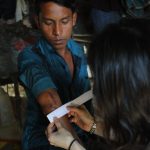This post originally appeared in the Asia Times
The suffering of the Rohingya survivors of the Myanmar military’s scorched-earth campaign of mass killings, torture, gang rape, and arson isn’t over. Not by a long shot. Just ask Rabia Basri, Abdul Wahid and Abu Gofar (not their real names).
Rabia Basri was 21 years old on August 27, 2017, when she fled into the rice fields surrounding her village of Chut Pyin in northwestern Myanmar’s Rakhine province with a group of family members as government security forces entered the village. Five of those relatives were shot dead in a hail of gunfire. Rabia Basri sustained gunshot wounds to her left leg and right arm, but those wounds – untreated for two days while family members carried her to nearby Bangladesh – have left her unable to walk or bear weight without the use of crutches.
Abdul Wahid was six years old when Myanmar security forces shot him in the head and left leg on September 5, 2017, while he and his family were escaping their northwestern Rakhine village of Morikorum. Two days later he underwent surgery in Bangladesh, but his shattered left leg has left him with a profound limp that makes walking extremely difficult.
Abu Gofar was an 18-year-old student in the northern Rakhine village of Thombajur-Kundpara in August 2017 when a heavily armed group of military personnel opened fire on him and some of his classmates as they walked home from school. He remembers a burning sensation and an explosion. His family carried him to safety in Cox’s Bazar, Bangladesh, but those wounds have left him blind in his left eye and deaf in his left ear, two long-term disabilities that severely hamper his ability to communicate.
Rabia Basri, Abdul Wahid and Abu Gofar are the lucky ones. They survived the widespread and systematic violence unleashed on Rohingya villages in northern Rakhine state in August 2017 by Myanmar security forces and Buddhist Rakhine civilians. That violence resulted in the torching of hundreds of Rohingya villages, killed at least 10,000 Rohingya civilians and prompted about 740,000 others to flee for their lives to Cox’s Bazar in neighboring Bangladesh, where they remain in precarious conditions.
A new Physicians for Human Rights (PHR) report released on Tuesday highlights an underreported legacy of that violence: Rohingya who survived being shot, beaten or stabbed by Myanmar security forces but whose wounds have resulted in long-term physical disabilities. The disabilities will hinder these survivors’ ease and freedom of movement, limit their ability to seek gainful employment, and otherwise obstruct their ability to live productive, pain-free lives.
The plight of these disabled survivors highlights how the ruthless violence that the Myanmar security forces and others inflicted on the Rohingya in August 2017 will have a decades-long, painful, life-altering legacy for so many survivors and their families.
PHR’s research focused on 114 survivors in the refugee camps in Cox’s Bazar who gave their consent to be interviewed. PHR medical partners identified 90 survivors out of that pool of 114 who reported physical injuries resulting from the violence. Those 90 survivors consented to and subsequently underwent clinical evaluations by PHR. PHR’s clinical evaluations determined that 43 of these injured survivors were left with long-term disabilities as a result of violence they experienced in or around August 2017.
The vast majority of those Rohingya disabled as a result of that targeted violence were gunned down as they fled attackers. PHR clinical evaluations determined that those bullet wounds have resulted in permanent neurological impairment that limits limb function and causes severe and persistent pain: Both can make simple tasks like walking, grasping a pot, or lifting a bag of rice extremely painful or impossible.
Other survivors suffered shrapnel wounds from grenades or were injured by landmines laid in fields surrounding villages in an apparently deliberate strategy to inflict maximum harm on Rohingya fleeing the attacks. PHR clinicians have concluded that a lack of prompt and adequate medical attention often exacerbated already severe wounds; these injuries were often worsened by delayed surgery, while infections led to amputations that earlier treatment might have prevented.
The suffering inflicted on Rohingya civilians in 2017 will likely have a decades-long legacy in the form of untold numbers of survivors with long-term disabilities. This in addition to the destruction of their communities, loss of their land, and widespread loss of life underscores the urgent need for accountability for those crimes.
Myanmar security forces should be investigated for possible crimes against humanity, and there needs to be renewed political will among United Nations member states to support recommendations by a UN fact-finding mission to refer Myanmar to the International Criminal Court or an ad hoc criminal tribunal for accountability for those abuses.
UN member states that are party to the 1948 Convention on the Prevention and Punishment of the Crime of Genocide (“Genocide Convention”) and which have already recognized the crimes against the Rohingya as genocide – including Canada and Malaysia – should file complaints to the International Court of Justice on the Myanmar government’s violation of the Genocide Convention and press the ICJ to seek reparations.
And for the disabled Rohingya survivors including Rabia Basri, Abdul Wahid and Abu Gofar, the UN Special Rapporteur on Disability should undertake a systematic assessment of the Rohingya population disabled in the August 2017 violence. The assessment should have the goal of triaging the most serious cases for immediate treatment and for longer-term rehabilitation and vocational training with transition to economic dependence, and psychosocial support of those individuals.
Without meaningful steps toward accountability for the violence of 2017 and direct support for those disabled by it, the unhealed wounds of that bloodshed will only fester.

